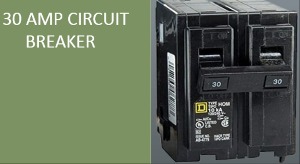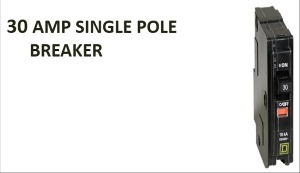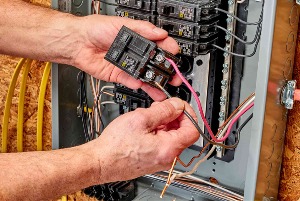
A 30 amp breaker is used to protect the circuit and appliances from overload, power surge, and electrical hazards. It is a safety device for heavy appliances that require higher energy to work.
Circuit breakers come in different ratting and amperage such as 3A, 5A, 15A, 20A, 25A, 30A, 40 A 50 A and others.
However, we shall discuss a 30-amp breaker, its use, buying and installation guides. Keep on reading for more details.
What is a 30 Amp Breaker?
A 30 amp breaker is a type of circuit breaker designed to handle a maximum current of 30 amperes. They are used to protect high powered appliances such as dryers, water heaters, air conditioners and others.
The 30 amp rating allows it to handle a large load without overloading or breaking itself.
If you were to overload a 20 Amp 120-volt circuit, it would only handle 2,400 watts, but with a 30 Amp device, it can even handle a water heater pump that requires 6000 watts.
Why use a 30 amp circuit breaker?
A 30 A breaker is necessary if you are running a power hunger appliance such as a dryer, air conditioner, or microwave that requires greater power than what is available on a 20-Amp breaker.
With a 30 A breaker, you can connect up to 30 Amps on a single circuit without having to upgrade to a larger breaker.
Types of 30 amp circuit breaker
There are two main types of 30 amp circuit breakers, they include:
- 30 amp single pole breaker
- 30 amp double pole breaker
30 amp single pole breaker

This circuit breaker usually comes in a slim design and also has a single hot wire. They are mostly used in commercial and industrial sittings, for some specialized appliances and tools.
30 amp double pole breakers
A 30 amp double pole breaker comes with two hot wires and a neutral wire. It is used on 240 volts heavy appliances such as dryers, water heaters, ovens, and others.
How many outlets can a 30 amp circuit handle?
The maximum outlet a 30 A breaker can handle is 16 outlets. Normally, a single device draws a maximum power of 180 watts (1.5 amp), while a 30-amp circuit carries a maximum load of 7200 watts before tripping.
Since the National Electric Code (NEC) recommends 80% or less load for breakers and circuits, the 80% of 30 amp should be 24.
To calculate the exact number of outlets a 30 amp breaker can carry, divide 24 by 1.5, you get 16.
What size wire do I need for a 30 amp breaker?
A 30 amp circuit breaker will need a 10 gauge wire to work perfectly. Using the wrong wire gauge may lead to electrical hazards.
The table below shows the different amps of breakers and their normal wire gauge.
Circuit breakers Wire size/Gauge
| Circuit Breakers (Amps) | Wire Size/Gauge | Where it is used |
| 200 Amps | 3/0 Gauge | Service entrance |
| 150 | 1/0 | Feeder wire and service entrance |
| 100 | 3 | Feeder wire and service entrance |
| 50/55 | 6 | Large appliances and feeder wire |
| 40 | 8 | Large appliances and feeder wire |
| 30 | 10 | Air conditioning, dryers, and appliances |
| 20 | 12 | Appliances, bathroom circuits and laundry |
| 15 | 14 | Light bulbs and small appliances |
Uses of a 30 A circuit breaker
A 30 A breaker typically works on 240 volt circuits. This can be as an extension cord, a plug, an in-wall outlet, or a whole-house circuit.
It is also useful when running a large load, such as a washing machine, dryer, water heater, air conditioner, cooker unit and others.
When running these large appliances, the device ensures that there is adequate voltage to support the load.
How to install a 30 amp circuit protector
Installing or replacing an old breaker is purely the work of a licensed electrician. But a DIYer with wiring experience can also do that.
Before you start, make sure that the circuit breaker and the electrical panel are from the same manufacturer.
On no account should you install a Square D product from Schneider Electric into an Eaton breaker box.
Also, make sure that the amperage rating of the breaker matches with the wire gauge and the powered appliance.
For example, a 20-amp 240-volt circuit works with 12-gauge wire, 30-A goes with 10-gauge wire; 40 A with 8-gauge wire; 50-A with 6-gauge wire, 60 A with 4 awg copper wire, and so on.
Required tools and materials
- Plier
- Screwdriver
- Wire stripper
- Multi-meter
- 30-A, 240-volt double-pole breaker.
Procedures
Turn off the power
Locate your main breaker panel and switch off the electrical line. Remove the cover plate and test with your multi-meter to make sure there is no light.
You can test for electricity by placing one of your testers probe to the screw of one breaker and placing the other probe on any metal part of the panel. Make sure the tester doesn’t light up.
Also, you can put on your protective glove to ensure maximum safety.
Strip the circuit wires with your wire stripper
Draw the wires into the breaker box and strip the lengths that can enter the screw terminals.
Connect the wires

Connect each of the hot wires to one terminal of the new device. Depending on the old wiring system, there might be a black and red wire, two black wires, or a black and white wire marked with black tape to show it is a hot wire.
Insert each wire into one screw terminal and tighten the connection with your screwdriver.
Install the breaker
Install the stab lok into the panel and make sure it fits in properly.
Connect earth and neutral cable
Connect the earth wire to the earth bar, and the neutral to the neutral bar, respectively, and complete the installation.
Difference between single pole and double pole circuit breaker
The difference between them lies in their wiring system.
A single pole comes with two wire terminals, one for hot wire and the other for neutral wire.
While a double pole comes with two terminals for hot wires and a single terminal for a neutral wire.
Secondly, a single-pole breaker supports only 120 volts and 12 to 20 amps, while double poles support 240 volts with an electric current ranging from 20 to 60 amps.
How to identify a 30 A circuit interrupter
All circuit breakers by law, supposed to have a classification plate. The plate will specify the amp rating, manufacturer, and type.
The Amp rating is the maximum current the breaker can interrupt safely. The breaker type can either be a single pole, two poles, or others.
Frequently Asked Questions
What do you use a 30 A circuit breaker for?
A 30 A receptacle is used to protect power hunger appliances like water heaters, cooker units, dryers, and others from overload and short circuits.
Related articles